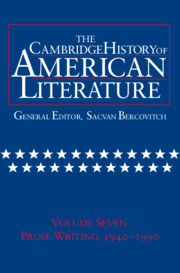Book contents
- Frontmatter
- Introduction
- The Drama, 1940—1990
- Fiction and Society, 1940–1970
- 1 War and the Novel: From World War II to Vietnam
- 2 The New Fiction: From the Home Front to the 1950s
- 3 On and Off the Road: The Outsider as Young Rebel
- 4 Apocalypse Now: A Literature of Extremes
- After the Southern Renascence
- Postmodern Fictions, 1960–1990
- Emergent Literatures
- Appendix: Biographies
- Chronology, 1940–1990
- Bibliography
- Index
2 - The New Fiction: From the Home Front to the 1950s
from Fiction and Society, 1940–1970
Published online by Cambridge University Press: 28 March 2008
- Frontmatter
- Introduction
- The Drama, 1940—1990
- Fiction and Society, 1940–1970
- 1 War and the Novel: From World War II to Vietnam
- 2 The New Fiction: From the Home Front to the 1950s
- 3 On and Off the Road: The Outsider as Young Rebel
- 4 Apocalypse Now: A Literature of Extremes
- After the Southern Renascence
- Postmodern Fictions, 1960–1990
- Emergent Literatures
- Appendix: Biographies
- Chronology, 1940–1990
- Bibliography
- Index
Summary
There were other war novels besides those set in the armed forces or at the front, novels that dealt with World War II more obliquely or were set on what was then called the home front. A number of these books anticipated the direction of postwar fiction more acutely than did the combat novels. Though ambitious young writers like Norman Mailer and James Jones dreamed that the war could provide material for the Great American Novel, the naturalist methods of the early war novels were discarded when American society, without reverting to isolationism, turned in upon itself during the Truman and Eisenhower years. The new writers were influenced less by the war than by rapid onset of the Cold War and of nuclear weapons so soon after the shooting war, which fostered anxieties that America’s victories abroad might otherwise have laid to rest, and by the new therapeutic culture of psychoanalysis, which gradually replaced the social consciousness that had driven much of American literature and visual art during the Depression. As American power and prestige expanded outward across the world, at home artists and writers looked inward, sometimes boastfully, often fearfully, to explore the existential dilemmas of selfhood. Europe had been broken as a dominant political and economic force, but strands of European culture, from modernism and surrealism to existentialism, had migrated to America. As America entered an era of prosperity and international dominance, American artists and writers grew pessimistic and introspective, like troubled prophets brooding darkly at the banquet of national celebration.
- Type
- Chapter
- Information
- The Cambridge History of American Literature , pp. 135 - 164Publisher: Cambridge University PressPrint publication year: 1999

